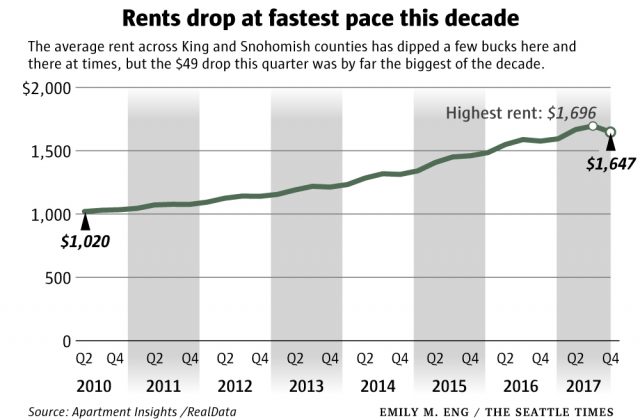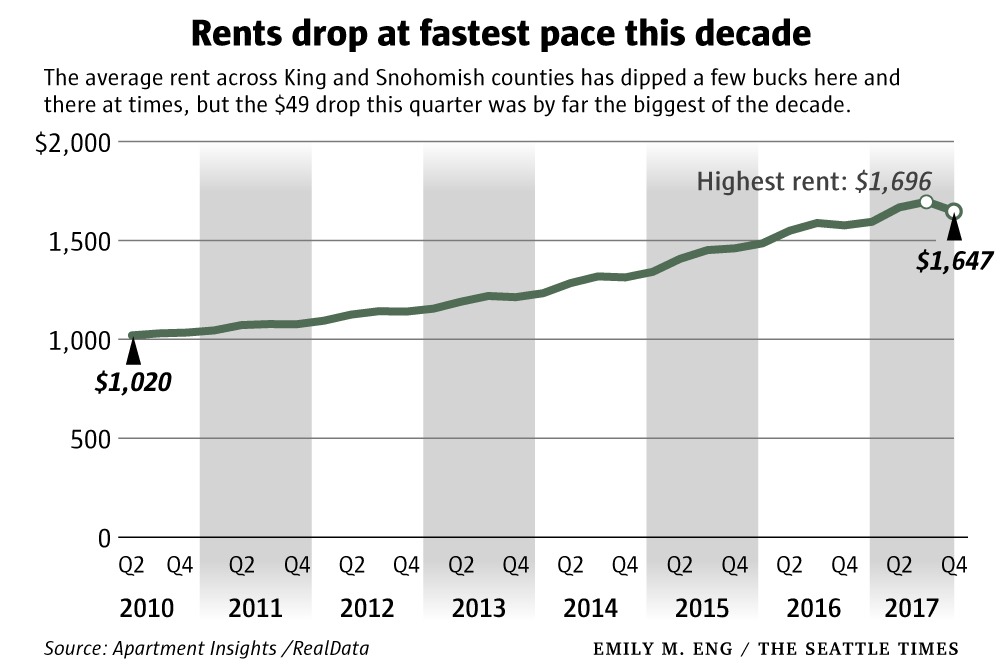From a Builder: Forced Into a Corner
A few years ago I got a call (as I often do) from a housing builder who had some issues with his project. We talked through them then and he kept going. More than three years later he got in touch to let me know the project is done and leased up. But think about that for a minute: three years. Why? Because while a recent Seattle Times article showed that supply is starting to catch up in the race against demand, people who build housing are still facing a gauntlet of regulatory overreach that provides no public benefit but adds costs with delays and forced increases to the size of units. As this builder points out, the project he as able to bring on line wouldn’t even be possible today. We need the Mayor to help reduce delays and for the Council to stop with more rules, regulations, fees, fines, taxes on the production of a good thing many people need and can afford if we just could get it to them.
We finally finished our Small Efficiency Dwelling Unit (SEDU) building in Seattle 3.5 years after acquisition. Admittedly, some of that delay was our own doing, but some of it was attributed to Seattle Department of Construction and Inspection’s (SDCI) definitions of “¼ mile frequent transit.” There were a couple times during permitting that we thought we might lose the project altogether and had to pause due to SDCI making it difficult on us.
Our building is very popular. Residents’ professions range from tech, culinary / restaurant, healthcare, accounting, and beyond. Most of our residents either wanted to live on their own and didn’t want to pay 1BR prices, or it is all they could afford. Some can afford more, but chose to minimalize their lives and live with less. Some are there for the eco-friendly aspect. Some are just trying to get out on their own. Most enjoy the central location and love how connected it is to the city.
The “transient” population that was a concern about a lot of people in this sort of housing just doesn’t exist here. Our residents are very respectful and love this building. They love the location and they appreciate that our product is actually affordable and nice.
This is what the City government forces developers like us into with these code changes – to either build a more expensive end-user product to cover the higher costs, or to not build at all. Either way, it is the government forcing the private market into a corner, then it turns around and blames the developers for high rents.
Here is the bad news: If we had this same lot and wanted to build this exact building today, based on current City of Seattle code, we would not be able to replicate it. If we were to acquire the exact same lot today with identical zoning, units would have to be larger, per new code. We would also require an upper-level setback, which would all result in fewer units. This would reduce unit count by 25-30%, which means less of these inexpensive units on the market to meet the very high demand.
The only way to make a project pencil for a developer in this scenario is to build larger units out to the building footprint limits and charge rent prices commensurate with the larger unit sizes. Because the units are bigger and there are less of them, you have to charge more to cover development costs. Odds are that we would probably just not build if we had to work under the new and “improved” land use and zoning code, and would either develop spec town homes that sell for $800 – $900K each, or sell, which would surely be purchased by a town home developer.
It might even make sense to go try this product in a different, more welcoming city to actual density.
This is what the city government forces developers like us into with these code changes – to either build a more expensive end-user product to cover the higher costs, or to not build at all. Either way, it is the government forcing the private market into a corner, then it turns around and blames the developers for high rents.
We have another project on a small lot that is required to have the larger-sized SEDUs. That alone is pushing feasibility to the brink. If we weren’t grandfathered in the pre-upper-level setbacks and elimination of free exterior walkway Floor Area Ratio (FAR) code, we for sure wouldn’t be able to develop this into SEDUs. We aren’t sure what we will do with it at this point, as we are forced into larger units. But the point is that the city might lose actual affordable housing if we end up selling this to a town home developer or don’t build at all on this lot. They are making it very hard for us. Let the free market take the risk instead of the law forcing a product in the market. If we fail, that’s our problem. If we succeed, then everyone succeeds and actual affordable housing can be created.
I’m sure you’ve heard it over and over, but I wanted to show you the real-life consequences.
Does Senator Pedersen Support or Oppose Rent Control in Seattle?
If I were a political consultant here’s the answer I’d advise a Seattle politician to give on the question of rent control if they wanted to win election and preserve some of their intellectual integrity on rent control: “I oppose rent control on the basis that it simply doesn’t work to lower prices for rental housing, however, I do think that whether rent control gets imposed is a local decision best left to local governments.”
Then I’d take a shower.
The fact is that one is either for or against rent control whether it is debated and imposed by the state or local government. It is bad policy. But good policy and politics are two very different things that sometimes overlap and sometimes don’t. Senator Jamie Pedersen is walking this line between policy and political reality on rent control. So we wrote him a letter urging him to oppose efforts to repeal the State preemption on rent control proposed in House Bill 2583.
January 12, 2018
Senator Jamie Pedersen
PO Box 40443
Olympia, WA 98504
Dear Senator Pedersen,
Today at 7PM the Seattle Channel will air a discussion between Seattle City Councilmember Kshama Sawant and myself. In the lead in segment you suggest that you are against rent control rightly saying that it doesn’t work, suppressing housing supply and thus aggravating housing inflation. However, you said you were supportive of HB 2583, which repeals the State’s preemption of imposition of rent control by cities.
It is our view that if HB 2583 becomes law, it virtually assures that the City of Seattle will do exactly what you said it shouldn’t: pass a rent control measure. In 2015 the City Council passed Resolution 31620 supporting
Efforts by the State Legislature to allow local governments to propose ordinances that significantly increase the supply of rent restricted units and that protect tenants from sudden and dramatic rent increases. . . by modifying or repealing RCW 35.21.830 (emphasis mine).
A majority of the Seattle City Council is on the record supporting rent control as well. Therefore the repeal of RCW 35.21.830 in HB 2583 would ensure that the Seattle City Council would move ahead with rent control.
Seattle For Growth works on behalf of builders, developers, and people who own and manage rental properties. We are for more housing supply, and more housing means more housing opportunity and lower prices for people who need housing. Rent control is not the answer. Just today the Seattle Times reported that in your own district more supply is helping prices.
We’d urge your public opposition to HB 2583 and keeping the preemption in place because it is the best guarantee to prevent rent control in Seattle.
Sincerely,
Roger Valdez
Seattle Times Shocker: Supply and Demand Exists!
Here is the headline from a Seattle Times story last week: Seattle Area Rents Drop Significantly….
Wait. Is this the real Seattle Times? The one that consistently heralds the latest increase in average rents as “skyrocketing?”
At first I thought this was clever satire. Had the Seattle Times hired deconstructionist performance artist Charles Mudede to write for their real estate section? Would there be some gotcha communist joke in the text.
Rents are dropping significantly across the Seattle area for the first time this decade, as a flood of new construction has left apartments sitting empty in Seattle’s hottest neighborhoods.
and
The biggest rent decreases were mostly in the popular Seattle neighborhoods that are getting the most new apartments. Rents dipped more than 6 percent compared with the prior quarter in First Hill, downtown Seattle, Belltown, South Lake Union and Ballard, along with Redmond and the Sammamish/Issaquah area.
What?! Insert wow emoji here. They even have a chart!
I’m being very snarky of course. The Seattle Times does the same thing here that it always does: report averages without much analysis about the “why” behind the numbers. But for once, Mike “Sky Rocket Man” Rosenberg quotes an actual developer, Greg Smith, about his perspective on this.
“New projects don’t make sense — they don’t pencil” out, Smith said. “Most banks are aware of that now and are very, very cautious about the amount of debt they’ll put on a property. There’s definitely a change that has occurred. Some fellow developers are stepping back and saying, ‘I’m not developing now.’ ”
This thing that Rosenberg is seeing in his averages is what the media around here considers sort of the Loch Ness Monster: the effects of supply and demand.
Now this does not mean the hyperventilating headlines will stop. In fact, already in social media the supply deniers are coming up with all sorts of excuses about why this doesn’t matter. Also, the danger is the the City Council will say, “See, our production killing regulations aren’t hurting a thing! It’s business as usual!”
I take this data as encouraging and the reporting as satisfying. But overall, my reaction is the same as when Rosenberg writes about the average price of units “skyrocketing” and being out of reach to the average worker; I take it with a grain of salt. While money for bigger projects like the ones Greg Smith builds might be slowing down, there is still a lot of demand out there for all sorts of housing, and the regulations that City Council is considering, like imposing pointless bike parking requirements for car parking exempt projects, are still cramping supply.
The message of this article is really that concern is growing among some developers and banks that we may be hitting the peak. As I always point out, real estate development is not a casino; money is very conservative and expects solid data and results before committing. But the slight downward trend here is an indication that when more supply becomes available prices do go down. The Earth really does revolve around the Sun!
Rent Control Debate: Seattle For Growth on the Seattle Channel
Last week I debated Councilmember Kshma Sawant on proposed legislation, House Bill 2583, a bill that would repeal the decades old preemption on local governments imposing rent control. Rent control will be a big issue this month while the legislation moves through the process in Olympia. You’ll see I start right out with what we’re for. These were my notes for the conversation.
Seattle For Growth is a pro housing organization supported by builders, developers, and people who own and operate rental housing.
We are for:
- More housing supply
- Rent restrictions when they come with incentives like MFTE
- Cash subsidies to people short on rent
- Building housing on surplus city owned land — lots of it
- And finally, once we done all these we’re for subsidizing unit construction for the problem that’s left
We’re against
- Price controls that hurt supply,
- Controls that create disincentives to operate buildings efficiently for tenants;
- Controls that benefit a small number of people at everyone else’s expense.
Although Councilmember Sawant took up more time, I think I used what was left well. Check it out for yourself in the featured video above. Thanks to Morris Groberman for his help with the lead in segment.
Crosscut: More Housing Means We Can Use Public Resources Wisely
Crosscut recently posted an article, Affordable housing? It’s on Seattle’s wealthy, calls for building lots of publicly owned housing by taxing “the rich.” We support public investment in housing, especially through programs like the Multifamily Tax Exemption (MFTE) program that uses deferred tax revenue to incentivize creation of rent restricted units and vouchers. The building of subsidized housing units should be a last resort and only for those who need wrap around services and who earn little or no income. Here’s my response from a post on Facebook’s City Builder group.
Where to start.
First, if we know that when something is scarce and in demand then what follows is higher prices. We are for increasing supply by allowing housing producers to build more housing. This will positively impact price and in favor of people who need housing by making the market more competitive.
If you deny that increasing supply has this effect, then you will reach different conclusions. And like climate change not being a hoax because it’s cold outside today, supply’s relationship to price is real even though that new building down the street is charging $2100 for a new apartment.
With more supply, the private sector takes the risks and gets the benefit of production — and the loses when demand tanks. Producers can meet almost all the housing demand out there if they are allowed. Almost everyone has a cell phone today, and many have smart phones. This is because they are not artificially scarce through regulatory limits on production.
When the market fails to meet demand, that is when some buyers in the market cannot pay enough rent to cover the costs of production, financing, and operations, we ought to consider subsidies as a solution.
But we must be efficient with those subsidies. Non-profit subsidized housing is incredibly difficult to build and operate. One figure I recently heard is that along with high per unit costs (as much as $500,000 per unit) operating costs can be as much as $7500 per unit per year; that’s $1,500,000 a year for 200 units. It is extremely inefficient to build pricey units for people that are paying a hundred or even a few hundred dollars more rent than the normative standard (which is sloppy, but that’s another conversation). Rather we would start subsidies with a cash payment monthly to offset the cost burden of housing — or other costs.
When we’d done that, then we could consider who’s still left over, unable to pay and perhaps needing more than just a roof over their head. For this segment of the market, manageably small, we could build publicly owned housing.
The notion of shaking down the market and taxpayers for thousands of units for people who are already housed is absurd, inefficient, and unnecessary. Waiting around to do that makes it irresponsible too. It’s time to get out of the way of the market and let it solve as much of the problem as it can, then efficiently solve the rest of the problem with resources gathered from broad and fair taxation, particularly taxes on ineffecient use of land: single-family homes.






